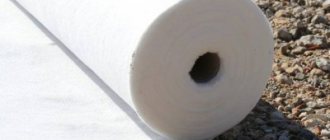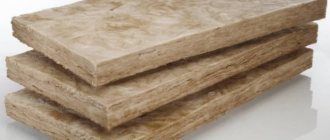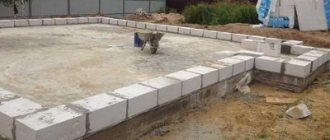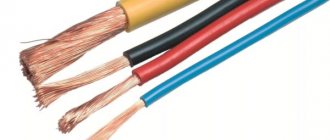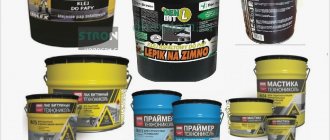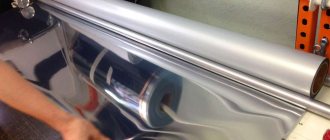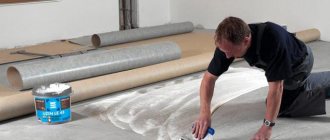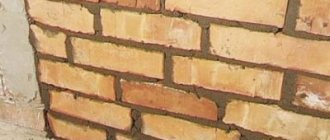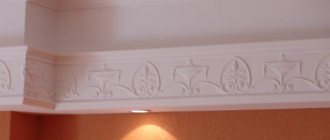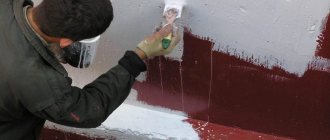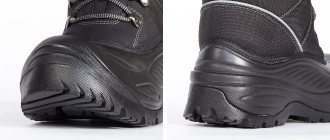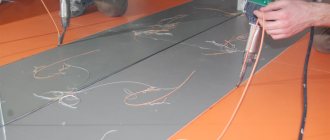The reliability and durability of the structure will depend on the quality of waterproofing work. Especially when it comes to foundation construction. Since the base is in the ground and is constantly subject to different loads, moisture can destroy the concrete. This includes groundwater in the soil and the surface influence of precipitation.
As a result, the concrete cracks and begins to collapse. A house like this won't last long. Therefore, the question of whether it is necessary to lay a roofing felt foundation is inappropriate. This is not a matter of desire; this is the technology of the device, which guarantees a long service life. Moreover, waterproofing materials can be purchased at an affordable price.
But a number of other questions arise, for example, which roofing material to choose for waterproofing the foundation? What types can be found on sale, how do they differ and how is waterproofing installed on the foundation? We will learn everything about roofing felt as a waterproofing material, as well as its use for different types of base.
Ruberoid - characteristics and features
This material has been used frequently in construction for a long time. It was first heard of at the end of the 19th century, when in the USA it began to be produced in the form of square sheets of cardboard impregnated with bitumen. Back then they were used for roofing work. This was the underlying temporary layer. Now the scope of use of cardboard impregnated with bitumen and protected on both sides with topping has increased. It is used as a waterproofing material for roofing, foundation, road, etc.
Ruberoid is a sheet rolled material. Translated, the word means rubber and the like. As in the past, it is made from a cardboard base impregnated with bitumen and other materials that make the waterproofing waterproof. Today there are many varieties of products that differ in their composition. The advantages of the material are its low cost, excellent waterproofing qualities, light weight and ease of installation. If we talk about the disadvantages, then this is a short service life and weakness to elevated temperatures. Since it is made from petroleum products, the risk of ignition is high.
To create a modern roofing felt sheet you need:
- cellulose fibers;
- non-woven material;
- polyester fiberglass.
The base of the roofing felt, which is polyester fiberglass, has high tensile strength, copes well with extreme weather conditions and withstands harsh elements. Another creation option is the use of cellulose fiber. This roofing felt is completely organic.
As for the types of roofing felt, they differ in composition. Here are 4 main types:
- Euroburoid, which is made on a synthetic basis. It is commonly used as a waterproofing roofing material for roofing.
- Rubemast - roofing material for foundations. The sheet is based on cardboard. The cost of production is low.
- Fiberglass ruberoid, which is based on fiberglass, making the material durable and tear-resistant. Most often used for installing the top and bottom roofing layers.
- Roofing felt, an ordinary cardboard sheet impregnated with bitumen. The material is protected on both sides by sprinkling. Most often used for a temporary waterproofing layer.
We arrange a pitched roof
A pitched roof is characterized by the installation of continuous sheathing, which is necessary to give the surface of the structure evenness and rigidity. Properly constructed sheathing will prevent the formation of uneven spots on the roofing material, which often cause very rapid wear and tear or damage from gusty winds.
To create the sheathing we will need:
- edged or unedged board;
- OSB or DSP board;
- plywood.
To give the roof slope a more reliable covering, there are three methods of laying it for the master to choose from:
- placing roofing felt sheets horizontally;
- along the slope line;
- composite method, when the next layer is laid at right angles to the previous one.
Any of these methods provides high-quality protection against water ingress.
Marking of roofing felt
Waterproofing the foundation with roofing felt is a responsible undertaking. Therefore, when choosing a material, you should pay attention to the brand of roofing felt that will be used for the work. It indicates the characteristics of the roofing material, what it is made of and what type of product it is. The brand consists of 3 letters and certain numbers.
The first letter is always P, as it indicates the material, roofing felt. The second letter indicates the purpose of the material; it can be roofing or lining (K, P). The third letter indicates the topping used. These are K - coarse-grained, M - fine-grained, H - scaly, P - dusty, C - colored. As for the number, it indicates the density of the product. Range 300–400 g/m2. Therefore, if you see the marking of roofing felt RKP-350, this means that it is intended for roofing and has a dusty coating. The density of roofing felt is 350 g/m2.
How many layers need to be laid?
Many people are often interested in the question of how many layers of roofing felt are required to be laid on the foundation for good protection. Their number should depend on the quality of the material used and the technical conditions. If, for example, you take roofing material RK, which is a roofing material, then 1 layer will be enough, because it is more durable and has a greater thickness than its analogue type RP, which is a lining. This kind of roofing material will require several layers for high-quality protection.
In addition, a certain number of layers of the material in question may be required if it is necessary to enhance waterproofing due to the presence of high groundwater levels. Layers are installed according to the principle of alternating canvas and mastic. And when everything dries, they make brickwork on top, which will press the roofing material with mastic for the highest quality waterproofing. Sometimes designers recommend using other materials instead of roofing felt.
Choosing roofing felt for waterproofing
Before laying roofing felt on the foundation, it must be selected. The choice depends on the characteristics and functions of the roofing material. As mentioned above, roofing felt can be used for roofing and lining. What is better for the foundation?
You can use roofing felt RKP-350, 400. Its advantages are that it is durable and resistant to moisture. RPP-300 is a good option, it is affordable and durable. Laying roofing felt on the foundation can be done in different ways. We'll talk about them further. Guided roofing material from Rubemast will help simplify the task. Rubemast is the ideal solution for foundation waterproofing. You will learn more about the features of one type of this roofing material from the following video:
Troubleshooting
Many home owners who missed the chance to timely install waterproofing between the masonry and the foundation turn to specialists for help. The difficulty is that the protective layer must be located along the entire perimeter of the box in its lower part. That is, in order to lay insulating materials, the building, in theory, needs to be dismantled or raised in some way. But such options are simply impossible and are not being considered.
In fact, there are a couple of ways to correct the situation. One of them does not require large financial investments, but it will take quite a long time to complete. The second option is somewhat simpler, but much more expensive. What to choose? We will leave the solution to this issue to the owner.
Waterproofing the foundation with roofing felt - features
To determine what set of measures is needed, the following factors should be taken into account:
- Presence of groundwater and its level.
- Heterogeneity of soil and amount of precipitation in the region.
- Terms of use of the building.
Waterproofing work on the foundation should be carried out when the groundwater level is below 1 m from the bottom of the foundation. Protection is carried out by vertical coating waterproofing, this will be enough. In the event that groundwater is located at a distance of less than 1 m from the bottom of the base, complete protection from moisture is carried out. In this case, they resort to the use of vertical penetrating waterproofing and the horizontal gluing method.
Note! When the groundwater level is at the same level as the basement, horizontal and vertical waterproofing is carried out, as well as the creation of a drainage system around the building.
Now regarding the heterogeneity of soil and precipitation. If the soil is dense, it does not allow moisture to pass through so well, which means it will accumulate on the surface. In this case, there is a risk of flooding the basement. Heterogeneity is directly related to the property of surface water to quickly sink into the ground during heavy rain, snow and other precipitation. Loose soil, which contains gravel, pebbles and sand, has excellent water permeability. With them, water quickly disappears into the soil. But sandy loam, loam and clay are waterproof soils.
But operating conditions also play a big role when it comes to the degree of protection of a building. For damp and damp rooms (saunas, baths, swimming pool complexes, etc.) high-quality waterproofing is needed. Also, the degree of protection, the amount of consumable materials, the order of work and their quantity are affected by the presence of heating in the building, residential premises and the area of the structure.
Video description
This video explains more about vertical waterproofing:
Horizontal
If a slab foundation is used, then you need to follow the standard scheme. Even before laying the roofing material, a trench 1 meter wide is dug around the slab. The depth of the trench depends on the size of the foundation. It is necessary to measure the thickness of the base and add an additional 50 cm. Then the slab is prepared for further processing - it is cleaned and treated with cement mortar to remove unevenness. After the primer layer, waterproofing is laid on the slab.
It is important that the roofing material layer is monolithic. That is, it must cover not only the horizontal surface, but also the sidewalls. If roofing felt is laid in several layers, then the second layer should lie across the first.
Laying technology based on foundation type
The algorithm for laying waterproofing may differ depending on the type of foundation. If the base is strip, then the insulation covers the supports. It is done either in the basement or on the ground floor. The main difficulty during installation is providing suitable conditions for the mastic. It should dry in a ventilated area. If the basement is wet, the material will not adhere well to the base.
Example of a strip foundation Source prom.st
Horizontal waterproofing
It is used almost always. The layer is needed to prevent moisture from the foundation from rising up the wall. The work is carried out at the construction stage, when the foundation has already been poured and it is time to lay the walls. In this case, the roofing material is laid on the foundation under timber, brick or other material. Horizontal waterproofing can be:
- pasting;
- painting (coating).
We are interested in glued waterproofing, since this is how you can lay roofing felt on the foundation. Bitumen is applied to the surface of the base, and roll material is glued on top. Instead of roofing felt, other rolled materials, such as hydroisol, brizol or isol, can be glued to the foundation.
Note! As for paint protection from moisture, it is carried out by applying bitumen mastic and synthetic materials.
In addition, built-up roofing felt is available for sale. How to glue roofing felt to the foundation? This requires a burner. With its help, you need to slightly melt the bottom layer of roofing felt and gradually glue it to the base. You will learn how to lay ordinary roofing felt on a foundation from this video.
Here are a few benefits of using roofing felt for this job:
- If the work is done correctly, the material will last up to 50 years.
- The products are cheap.
- The material is durable and elastic.
- Resistant to oxidation.
- It is not afraid of salts contained in the soil and groundwater.
- A universal material that is easy to install.
Installation technology
If waterproofing is carried out in a house that is already in use, at the first stage the outer wall of the foundation is dug out to its full height, cleaned of soil and dirt, the cracks are sealed and the surface is leveled. The next sequence of actions is as follows:
1. Prime the concrete with bitumen primer.
2. Apply a layer of mastic. You can use cold applied bitumen mastic.
3. Glue a sheet of roofing material onto the mastic. It is recommended to heat the material with a gas burner. The overlap of adjacent strips is up to 15 cm.
4. Place the mastic and the second layer of roofing felt again, observing the spacing of the seams in relation to the first layer.
5. If insulation is not carried out simultaneously with waterproofing, the wall is covered with sheets of plywood. Otherwise, PPS slabs are glued on top of the roofing felt and secured with dowels.
The insulation is protected from external mechanical factors by sheets of plywood, asbestos-cement or reinforced concrete slabs. For external treatment of the base, a durable facing material (for example, porcelain tiles) is suitable as a protective coating.
Horizontal waterproofing with roofing felt is done in the same way, only there can be more than two layers.
Vertical waterproofing
The essence of the work is to apply a protective layer to the inner and side surfaces of the foundation. Suitable for this purpose: bitumen mastic and dry mixture. Taking into account the operating conditions and the location of the base, vertical waterproofing can be:
- coating;
- penetrating.
The task of coating insulation is to provide a protective layer that will prevent contact of the base with moisture. Bitumen-polyurethane or bitumen-rubber mastic is used. After application, a waterproof layer is formed. Advantages: high strength, excellent elasticity, ease of application, hiding cracks during shrinkage. Cons: possibility of peeling off from the surface and short service life.
Note! Vertical waterproofing can be performed with the same built-up roofing felt.
As for penetrating waterproofing, it is carried out using mixtures that contain quartz sand, cement and active substances. The mixture is applied to the base from the outside and inside. It reacts with the material and fills pores and cracks. Then moisture will not be able to penetrate into the concrete.
Installation of protective ebb
The main purpose of low tide is to prevent moisture from appearing at the junction of the wall and the part of the foundation protruding outwards. They are made of metal or plastic.
Plastic castings are lighter and are not afraid of corrosion, but they are easily damaged during operation. Metal ones require monitoring of the condition of the protective paint, but in the case of complex foundation geometry, it is easier for them to give the required shape.
When installing basement flashings, a number of points need to be taken into account.
- Installation must be done before cladding the external walls.
- The presence of slopes helps maintain tightness. They are created from a cement mixture. The optimal slope of the slope surface is 15 degrees.
- The sills can be attached to the wall and to guides made of galvanized profiles or bars. They are nailed to the wooden base with ordinary nails, and the material is fixed to the profile with self-tapping screws.
To ensure tightness, the ebbs should be overlapped. Internal and external corners can be made from scraps of the ebbs themselves.
Methods for fixing roofing felt to the foundation
The best way to lay roll material is to glue it to the surface of a tile or strip foundation. Before laying the roofing material on the foundation, it is cut to the required size and gradually glued. It doesn’t matter whether bitumen mastic or built-up roofing material is used. The result is the same.
As for mechanical installation, which involves fixing sheets with nails and slats, it is not recommended to use it. It is not as effective, and the structure of the concrete will be damaged, which affects its characteristics.
Step-by-step instructions for waterproofing look like this:
- Preparatory stage. The base of the foundation is leveled and cleared of all unnecessary things. This will allow the rolled material to adhere firmly to the surface.
- Preparing roofing felt. The material must be cut according to the width of the foundation.
- Direct laying of roofing felt. The foundation is treated with bitumen mastic or melted bitumen. It will not only allow the material to stick to the surface, but will seal all cracks. Application is done with a roller or brush. When everything is ready, you can lay the roofing felt. The overlap at the joints is made from 8 to 10 cm. The edges of the material are hidden in vertical waterproofing.
- The final stage. When the layer has cooled and the material has stuck, the foundation is covered with soil. Everything is done carefully so that the protective layer is not damaged.
Note! It is not recommended to carry out waterproofing work at low temperatures and other unfavorable conditions. This way the material will lose its original properties, which will reduce its service life and the quality of waterproofing.
That's all, now the base is reliably protected from moisture and will last for many years. But, there is another question, what to do with the columnar base? After all, it also requires waterproofing. Let's start with the fact that sometimes roofing felt formwork is made for a columnar foundation, as can be seen in this photo.
It turns out that the concrete that will be poured into the roofing felt foundation pillars is already in the protective layer of waterproofing. In this case, it extends all the way to the bottom of the base. And then, before making a frame or grillage made of concrete or wood, a bedding made of roofing material, also known as horizontal waterproofing, is laid on the surface. Here's what it looks like in practice.
The advantage of this method of foundation construction is that less materials are consumed and its cost is several times lower. True, a columnar foundation is not suitable for heavy structures. But, if you are making it for a small house, then now you know how to waterproof it.
Note! This is one of the waterproofing options. Metal or asbestos-cement pipes are often used as formwork for pillars. In this case, they are treated with coating waterproofing.
Technology for arranging a waterproof layer
The least effective method of waterproofing is mechanical fastening of roofing material using nails or slats. However, currently existing materials in the form of mastics make it possible to effectively solve the problem of fixing sheet materials using them.
Preparatory activities
This work consists of leveling the surface of the foundation with a cement-sand mortar. It covers chips, cracks, shrinkage cavities and other surface defects that could subsequently cause mechanical damage to the insulating layer.
Might be interesting
Formation of a protective layer with roofing felt
To fix the roofing material, the surface of the foundation is covered with bitumen heated to a fluid state, while simultaneously placing a rolled sheet of material on it. Hot bitumen is applied with a brush or roller. The rows of roofing felt are laid with an overlap of 7 - 12 centimeters. The edges of the material along the entire perimeter are folded and covered with vertical waterproofing. For complete reliability, you should arrange 2 layers of protection.
Laying roofing felt with heating
Roofing felt laying technology
Work on waterproofing the foundation is carried out in the following order:
- Sealing cracks and defects with cement-sand mortar. After it hardens, treat the surface with a primer.
- Applying mastic in several layers.
- Heat the roofing material sheet with a blowtorch and lay it overlapping, while the joints are heated especially thoroughly and additionally glued with mastic.
- On top of the first layer of waterproofing, the second layer is laid in the same order (except for point 1), and, if necessary, subsequent ones.
Ruberoid-rubber insulation
This method of waterproofing is used quite rarely, but gives excellent results. In this case, special rubber in a liquefied state is used as a binding agent between concrete and roofing felt. In this case, the protective layer turns practically into a monolith endowed with elasticity.
This achieves the following advantages:
- rubber consumption is significantly reduced compared to pure rubber insulation technology;
- there is no need to apply heating to roofing felt, rubber provides high adhesion to roofing felt, acting like glue;
- In terms of durability, such waterproofing is comparable to the lifespan of the structure itself.
Additional protection
A natural moisture-proof material is ordinary clay, which is still widely used today for clay seals of the upper structure of water intake devices:
- To prepare such a material, the clay needs to be soaked for 24 hours with a small amount of water, and then stirred until it becomes a thick sour cream. To improve the quality of the composition, fiber shavings are added to it as a reinforcing element. When dried, it prevents the formation of cracks in the monolithic layer of clay.
- The foundation around the perimeter must be filled with such a solution to the level of the ground surface and left open to dry.
- The normal drying time for clay mortar is about 30 days, but work can continue after 7–10 days. If the weather is dry and hot, the surface of the fill should be covered with film and sprinkled with water daily to ensure that the layer dries evenly. Otherwise, it may suffer from cracking.
Creating a clay seal will protect the roofing material waterproofing layer from mechanical damage, since the seal layer is not compacted during the laying process.
Let's sum it up
The most common way to protect the foundation is to use rolled materials, namely roofing felt. Its advantage is simplicity, efficiency, low cost and reliability. Even a beginner can cope with this task. You just need to select the material, carry out the preparatory work and perform the installation. Thanks to this, the foundation and the entire building as a whole will last for decades, without the need for repair work and spending money on it. This is why waterproofing is an essential part of construction work that should not be neglected.
Recommended Posts
Bituminous mastic for waterproofing the foundation.
What kind of foundation is needed for a house made of aerated concrete?
Do-it-yourself USHP foundation
DIY strip foundation
Pile foundation with grillage
Types of waterproofing for foundations
